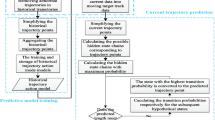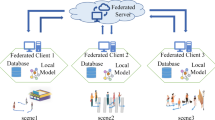Abstract
The automatic license plate recognition (LPR) system has the advantages of strong continuity, high data accuracy, and large detection samples. The detection data can be used as quasi and full sample sampling of road network vehicles. However, the system has the disadvantage of sparse geographical location, so the data is difficult to be used effectively. In order to obtain the full sample vehicle travel trajectory on an urban road network, this paper investigates the sparse trajectory recovery problem based on LPR data. A trajectory reconstruction algorithm based on the Markov decision process (MDP) in road network space is proposed. The algorithm is divided into two stages, including off-line training and on-line prediction. In the off-line training stage, the LPR data is transformed into the trajectory set represented by the link edge sequence in the road network space. The MDP model is used to describe the vehicle driving behavior, and the design rules of the link reward function in the model are discussed. An unsupervised Bayesian inverse reinforcement learning algorithm is proposed to train the historical vehicle trajectory data and learn the model parameters. In the online prediction stage, the transfer probability between links is calculated according to the trained model. The negative logarithm of the transfer probability modified by the spatio-temporal coefficient is used as the edge weight to construct a directed graph. The shortest path search is used to obtain the path with the highest probability to restore the missing path. The proposed method is implemented on a realistic urban traffic network in Ningbo, China. The comparison with the baseline algorithms indicates that the proposed method has higher accuracy, especially when the coverage rate of the LPR device is low. When the coverage rate is more than 60%, the comprehensive accuracy of the proposed algorithm is more than 85%, and reliable path estimation results can be obtained.













Similar content being viewed by others
References
Ashbrook, D., Starner, T.: Learning significant locations and predicting user movement with GPS. In: Paper presented at the Proceedings. Sixth International Symposium on Wearable Computers. (2002)
Azam, S., Islam, M.M.: Automatic license plate detection in hazardous condition. J. vis. Commun. Image Represent. 36, 172–186 (2016)
Becker, R., Cáceres, R., Hanson, K., Isaacman, S., Loh, J.M., Martonosi, M., Volinsky, C.: Human mobility characterization from cellular network data. Commun. ACM 56(1), 74–82 (2013)
Berger, J.O.: Statistical Decision Theory and Bayesian Analysis. Springer Science & Business Media, Berlin (2013)
Cao, Q., Ren, G., Li, D., Ma, J., Li, H.: Semi-supervised route choice modeling with sparse Automatic vehicle identification data. Transp. Res. Part c: Emer. Technol. 121, 102857 (2020). https://doi.org/10.1016/j.trc.2020.102857
De Domenico, M., Lima, A., Musolesi, M.: Interdependence and predictability of human mobility and social interactions. Pervasive Mob. Comput. 9(6), 798–807 (2013)
Dewri, R., Annadata, P., Eltarjaman, W., Thurimella, R.: Inferring trip destinations from driving habits data. In: Paper presented at the Proceedings of the 12th ACM workshop on Workshop on privacy in the electronic society. (2013)
Feygin, S.: Inferring structural models of travel behavior: an inverse reinforcement learning approach. University of California, Berkeley (2018)
Fosgerau, M., Frejinger, E., Karlstrom, A.: A link based network route choice model with unrestricted choice set. Transp. Res. Part B Methodol. 56, 70–80 (2013)
Fu, X., Sun, M.-p., Sun, H.: Taxi commuting recognition and temporal-spatial characteristics analysis based on GPS data. (2017)
Hu, Z., Liu, L., Wang, K.: The extraction method of travelling path based on identification data of the license plate from bayonet system. Geomat. Sci. Technol. 6(4), 356–362 (2018)
Kamrani, M., Srinivasan, A.R., Chakraborty, S., Khattak, A.J.: Applying Markov decision process to understand driving decisions using basic safety messages data. Transp. Res. Part c: Emerg. Technol. 115, 102642 (2020)
Liu, Q., Cai, Y., Jiang, H., Lu, J., Chen, L.: Traffic state prediction using ISOMAP manifold learning. Phys. A 506, 532–541 (2018)
Ma, X.-L., Wang, Y.-H., Chen, F., Liu, J.-F.: Transit smart card data mining for passenger origin information extraction. J. Zhejiang Univ. Sci. C 13(10), 750–760 (2012)
Mao, J.Y., Wu, H., Sun, W.W.: Vehicle trajectory anomaly detection in road network via Markov decision process. Chin. J. Comput. 41(08), 1928–1942 (2018)
Nantes, A., Ngoduy, D., Bhaskar, A., Miska, M., Chung, E.: Real-time traffic state estimation in urban corridors from heterogeneous data. Transportation Research Part c: Emerging Technologies 66, 99–118 (2016)
Ou, G., Gao, Y.,Liu, Y.: Real-time vehicular traffic violation detection in traffic monitoring stream. In: Paper presented at the Proceedings of The 2012 IEEE/WIC/ACM International Joint Conferences on Web Intelligence and Intelligent Agent Technology-Volume 03. (2012)
Ozdemir, E., Topcu, A.E., Ozdemir, M.K.: A hybrid HMM model for travel path inference with sparse GPS samples. Transportation 45(1), 233–246 (2018). https://doi.org/10.1007/s11116-016-9734-2
Peng, Z., Shan, W., Guan, F., Yu, B.: Stable vessel-cargo matching in dry bulk shipping market with price game mechanism. Transp. Res. Part e: Logist. Transp. Rev. 95, 76–94 (2016)
Quddus, M., Washington, S.: Shortest path and vehicle trajectory aided map-matching for low frequency GPS data. Transp. Res. Part c: Emerg. Technol. 55, 328–339 (2015)
Ramachandran, D., Amir, E.: Bayesian Inverse Reinforcement Learning. In: Paper presented at the IJCAI. (2007)
Ross, S., Bagnell, D.: Efficient reductions for imitation learning. In: Proceedings of the thirteenth international conference on artificial intelligence and statistics (pp. 661–668). JMLR Workshop and Conference Proceedings (2010)
Ruan, S., Wang, F., Ma, D., Jin, S., Wang, D.: Vehicle trajectory extraction algorithm based on LPR data. J ZheJiang Univ. (engineering Science) 52(5), 836–844 (2018)
Shahpar, A.H., Aashtiani, H.Z., Faghri, A.: Development of a delay model for unsignalized intersections applicable to traffic assignment. Transp. Plan. Technol. 34(5), 497–507 (2011)
Sheffi, Y.: Urban Transportation Networks. Prentice-Hall, Englewood Cliffs (1985)
Sherali, H.D., Desai, J., Rakha, H.: A discrete optimization approach for locating automatic vehicle identification readers for the provision of roadway travel times. Transp. Res. Part b: Methodol. 40(10), 857–871 (2006)
Vajakas, T., Vajakas, J., Lillemets, R.: Trajectory reconstruction from mobile positioning data using cell-to-cell travel time information. Int. J. Geogr. Inf. Sci. 29(11), 1941–1954 (2015)
Vazquez-Prokopec, G.M., Bisanzio, D., Stoddard, S.T., Paz-Soldan, V., Morrison, A.C., Elder, J.P., Scott, T.W.: Using GPS technology to quantify human mobility, dynamic contacts and infectious disease dynamics in a resource-poor urban environment. PLoS ONE 8(4), e58802 (2013)
Wang, L., Chen, H., Li, Y., Deng, Y.: Track patching method for incomplete track in track-oriented traffic survey and analysis. Appl. Res. Comput. 31(1), 162–165 (2014)
Wang, H., Gu, C., Ochieng, W.Y.: Vehicle trajectory reconstruction for signalized intersections with low-frequency floating car data. J. Adv. Transp. 2019, 1–14 (2019)
Yan, X.-Y., Wang, W.-X., Gao, Z.-Y., Lai, Y.-C.: Universal model of individual and population mobility on diverse spatial scales. Nat. Commun. 8(1), 1639 (2017)
Yang, J., Sun, J.: Vehicle path reconstruction using automatic vehicle identification data: an integrated particle filter and path flow estimator. Transp. Res. Part c: Emerg. Technol. 58, 107–126 (2015)
Yang, M., Pan, Y., Darzi, A., Ghader, S., Xiong, C., Zhang, L.: A data-driven travel mode share estimation framework based on mobile device location data. Transportation (2021). https://doi.org/10.1007/s11116-021-10214-3
Yu, H., Yang, S., Wu, Z., Ma, X.: Vehicle trajectory reconstruction from automatic license plate reader data. Int. J. Distrib. Sens. Netw. 14(2), 1550147718755637 (2018)
Yuan, Y., Zou, W., Zhao, Y., Wang, X., Hu, X., Komodakis, N.: A robust and efficient approach to license plate detection. IEEE Trans. Image Process. 26(3), 1102–1114 (2016)
Ziebart, B.D., Maas, A.L., Bagnell, J.A., Dey, A.K.: Maximum entropy inverse reinforcement learning. Aaai 8, 1433–1438 (2008)
Funding
This work was supported in part by the Postgraduate Research & Practice Innovation Program of Jiangsu Province under Grant KYCX20_0137, and in part by the Fundamental Research Funds for the Central Universities under Grant 2242020K40063.
Author information
Authors and Affiliations
Contributions
LWH: research methodology, model development, manuscript writing; LCK: literature search and review, model development; WT and JYJ: supervision, validation, manuscript editing.
Corresponding authors
Ethics declarations
Conflict of interest
The authors declare no conflict of interests.
Additional information
Publisher's Note
Springer Nature remains neutral with regard to jurisdictional claims in published maps and institutional affiliations.
Appendix
Appendix
The probability of a path under a particular observation
Given an origin link \(o\) and a destination link \(d\), \(P\left( {\left( {y^{1} ,y^{2} , \ldots ,y^{J} } \right){\mid }o,d} \right)\) denotes that a driver is observed by the detectors \((y^{1} ,y^{2} , \cdots ,y^{J} )\) during a trip from link \(o\) to link \(d\). Since the first detector observation \(y^{0}\) is associated with a path in the link set \({\mathcal{L}}_{y} \left( {y^{1} } \right)\), \(P\left( {\left( {y^{1} ,y^{2} , \ldots ,y^{J} } \right){\mid }o,d} \right)\) can be expressed as follows:
where \(P\left( {\left( {l,y^{2} , \ldots ,y^{J} } \right){\mid }o,d} \right)\) is the probability that the first observed is link \(l\), followed by the detectors \(\left( {y^{2} , \cdots ,y^{J} } \right)\). We assume that actual choice is independent of historical choice. Eq. (A.1) can be further decomposed into:
The term \(P_{{y^{1} }} \left( {l\left| {o,d} \right.,\varepsilon } \right)\) is the expected probability observed at link \( l\) arrival under the detection rate \(\varepsilon\). \(P\left( {\left( {y^{2} , \ldots ,y^{J} } \right){\mid }l,d} \right)\) is the probability to reproduce the remaining detector observation path, starting at link \( l\). Substituting (A.2) into (A.1) can get the following recursive expression:
Rights and permissions
Springer Nature or its licensor holds exclusive rights to this article under a publishing agreement with the author(s) or other rightsholder(s); author self-archiving of the accepted manuscript version of this article is solely governed by the terms of such publishing agreement and applicable law.
About this article
Cite this article
Li, W., Liu, C., Wang, T. et al. An innovative supervised learning structure for trajectory reconstruction of sparse LPR data. Transportation 51, 73–97 (2024). https://doi.org/10.1007/s11116-022-10320-w
Accepted:
Published:
Issue Date:
DOI: https://doi.org/10.1007/s11116-022-10320-w




